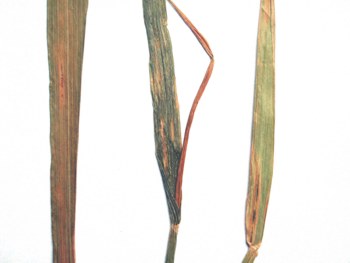Diseases
Ascochyta hordei Hara - Ascochyta Leaf Spot.
Systematic position.
Conidial stage (or anamorph) A. hordei belongs to class Deuteromycetes, order Sphaeropsidales, family Sphaeropsidaceae, genus Ascochyta. Sexual stage (teliomopth) is named as M. tassiana and included into class Ascomycetes, order Dothideales.Biological group.
Hemibiotrophic wheat pathogen.Morphology and biology.
The fungus causes Ascochyta Leaf Spot of wheat. Early lesions are distinct, round or oval, with dark brown border, lighter internally. Advanced lesions are diffuse. Leaves become dirty-gray and dry up. The pycnidia are visible in the center of spots. The fungus survives as mycelia and pycnidia in host residues. Spots appear on winter wheat leaves in early spring, and later the fungus infects spring wheat. Pycnidia are spherical, dark-brown, sunken, to 165 mkm in diameter. Conidia are widely oblong, with 1 (sometimes 2) septa, 15-23 x 4.5-6 mkm.Distribution.
Ascochyta Leaf Spot occurs in a complex together with different leaf spot diseases forming potential pathogenic mycobiota. The disease is zonally distributed; it can have strong development only in some favorable for the fungus years. The fungus damages stronger winter wheat than summer one. The disease is registered in Kirov, Voronezh, Leningrad, Rostov Regions, Stavropol and Krasnodar Territories, in Ukraine, southern Byelorussia and North Ossetia (Alania).Ecology.
The destruction of winter wheat after Ascochyta Leaf Spot is observed in years when seedlings develop insufficiently since autumn, and also after thick snow cover in winter. During vegetation period the disease can develop in wet and warm summer.Economic significance.
The pathogen infects wheat, barley, and rye. As a rule, the disease has minor economic importance and occurs in a complex together with different kinds of leaf blotch. Protection measures include autumn ploughing, isolation of spring wheat from winter one, application of phosphorus-potash chemicals in autumn, crop rotation, growing of resistant cultivars.Related References:
Ephimova G.G. 1995. Phytopathological situation developed by technology of winter wheat growing in dry zones of Stavropol Territory // Zashchita zernovykh kultur ot boleznei v sovremennom zemledelii (Sbornik nauchnykh trudov).- SPb. -N98.-P.-97-104 (in Russian).Fissura N.I., Andronova A.E., Bessmel.tsev V.I. 1996. Pathogens of fungus spot on wheat in main cereal growing zones of Krasnodar Territory //Doklady Rossel.khozakademii. N1.-P.9-11 (in Russian).
Gontarenko O.V., L.T.Babayants, Gerzhova M.A. 1998. Leaf spots of wheat and triticale in south Ukraine // Mykologiya i phytopatologiya. -V.32(2).-P. 61-64 (in Russian).
Gorlenko M.V. 1951. Wheat diseases.-Moscow.- 256 pp. (in Russian).
Manukyan I.R. 2003. Pathogens of winter wheat in North Ossetia // Zashchita rastenii i karantin.-N 1. -P.32-33 (in Russian).
Polozova N.L. 1969.Ascochyta spp. on cereals in Leningrad Region //Mykologiya i phytopatologiya.-V.3, №2.- P.188-192 (in Russian).
Rudakov O.V, Titova K.D., Pospekhov G.V., Fissura N.I. 1989. Zones of harmfulness of leaf spot blotches pathogens //Povyshenie produktivnosti i ustoichivosti proizvodstva zerna ozimoi pshenitsy v SSSR (Sbornik nauchnykh trudov).-Mironovka.- P.134-139 (in Russian).
Shestiperova Z.I., Polozova N.L. 1973. Powdery mildew and leaf spots of spring wheat.-Leningrad: Kolos.- 56 pp. (in Russian).
Vlasov D.Y., Nikitina E.V., Zhukova M.V. et al. 1995. The composition of Micromycetes species on cereals in Rostov Region. //Zashchita rastenii ot boleznei v sovremennom zemledelii (Sbornik nauchnykh trudov).-SPb.- N98.-P.-82-92 (in Russian).


